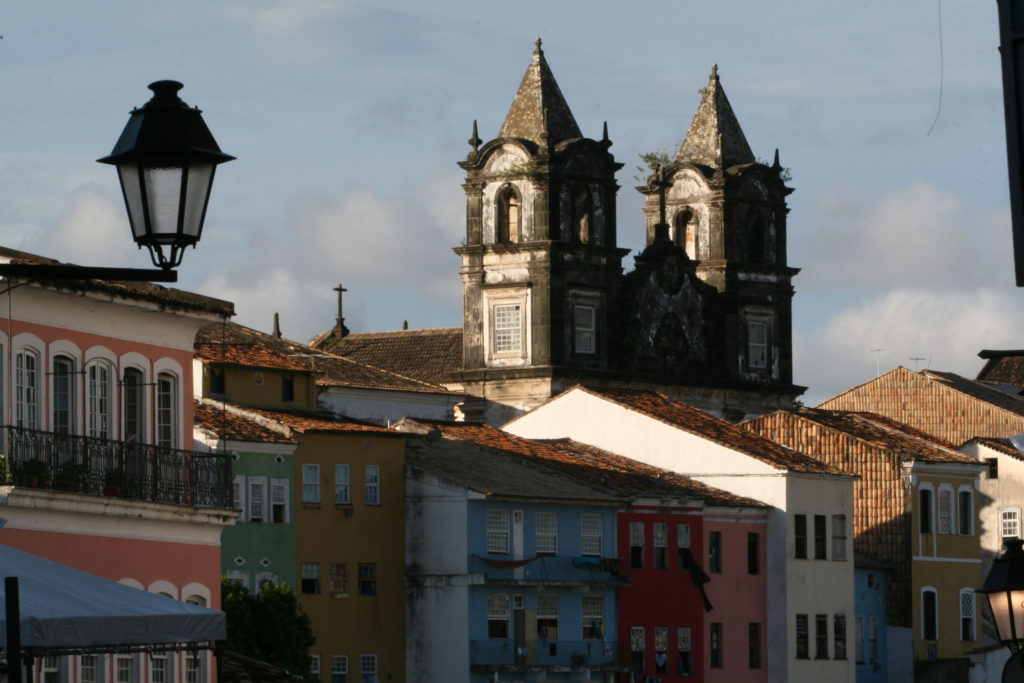Salvador da Bahia is a city dripping with history and culture. Founded in 1549 as Brazil’s first capital, some 80% of the city’s population is of African descent. Salvador and the state of Bahia serve as the birthplace of typically “Brazilian” cultural markers: the martial art of capoeira; the syncretic religion of Candomblé, which combines West African and Roman Catholic religious traditions; the samba de roda, the root of Rio-style samba; and feijoada, the bean-based stew ladled nationwide on Saturdays as Brazil’s national dish. With gorgeous architecture, fun and friendly people, and great beaches, Salvador will capture your heart. And don’t forget, Carnival is coming up—the party runs from February 9-14, 2018.
Nickname: SSA and Roma Negra (Black Rome) | Population: 2.9 million baianos/4 million in metro | Area: 268 sq mi | Airport: Luís Eduardo Magalhães International Airport (SSA) | Time Zone: -3h from UTC/-2h DST | Famous for: Afro-Brazilian culture, axé, beaches, beats, capoeira, Candomblé
On arrival: Use the free airport wifi to order a ride via Uber, or take a cab from one of the prepaid taxi offices closest to the terminal exit; insist that the driver uses GPS. The best and least-expensive way to get reais (Brazilian currency) is to withdraw money from the ATM; many Brazilian ATMs do not operate using the U.S. bank card network, but at least one or two will.
Best ‘hoods: Pelourinho is Salvador’s beautiful historic quarter. The name comes from the Portuguese for “whipping post,” which speaks to the city’s sordid past as a center for human trafficking and chattel slavery. That said, the vibrant color, inescapable music, and scrumptious food of Pelourinho speaks to the human ability to rise above suffering and thrive in the face of it. The Cidade Baixa hosts some of Salvador’s attractions, while the beach districts of Barra and Ondina attract swimmers, surfers, and sun-worshippers from all over. Nearby, the island of Itaparica and the villages of Morro de São Paulo and Cachoeira offer beautiful day-trip options with a mix of history, culture, and nature.
Best beaches: Praia do Farol da Barra and Ondina for swimming and flirting; Porto da Barra and Rio Vermelho for great sunset views; Armação, Jaguaribe, and Stella Maris for surfing; Praia do Forte and the beaches of Itaparica for peace and quiet.
Best sights: Pelourinho, churches of Nosso Senhor do Bonfim and Nossa Senhora do Rosário dos Pretos, Elevador Lacerda, Mercado Modelo, Ilha dos Frades and ferry rides on the Baía de Todos os Santos, Pelourinho and Barra/Ondina during Carnival.
Best eats: Churrasco (Brazilian barbecue) at Boi Preto Grill, feijoada (the national dish) at Boteco or Mini Cacique, comida baiana (local Bahian cuisine/seafood) at Donana or Ki-Mukeka, por kilo (Brazilian buffet) at Mignon or Sinhá, comida mineira (rustic Brazilian food) at Taiobha, açaí na tigela (frozen açaí) at A Cubana or at the Praia do Farol da Barra, pork sandwiches at O Líder, pizza at Pizza da Chapada, sushi at Soho, Brazilian vegan/veg at A Saúde na Panela or Rango Vegan.
Best dranks: Juices at Suco 24 Horas or Ácidos Naturais, beers at Rhoncus Pub, happy hour at Caminho de Casa or in Pelourinho, views and friends at O Cravinho, Barraca do Lôro, or Toro Tapas Bar.
Best hypes: Afternoons and evenings in Pelourinho for amazing live music and delicious food, upscale partying at Tarantino Art Bar, casual fun at Coliseu do Forró, LGBT club nights at Tropical or San Sebastian, Barra and Ondina for New Years (Reveillon) and during Carnival.
Best sounds and scenes: Carlinhos Brown, Margareth Menezes, Olodum, and Daniela Mercury, just to whet the musical appetite. Capitães da Areia and Gabriela Crave e Canela for cinematic eye candy.
Best advice: Remember to be street-smart at all times; leave unnecessary valuables at home. Try to speak a little bit of Portuguese; you’ll make new friends that way. Service in restaurants and other establishments can be slow; try not to let that ruin your trip to such an incredibly memorable place. Use condoms. Have fun!
Image credit: GOVBA

